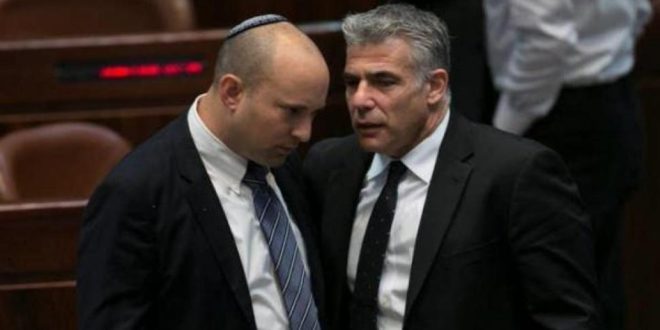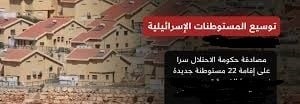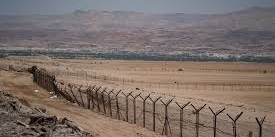By : Madeeha Al-Aaraj
The National Bureau for defending land and resisting settlements ( nbprs ) stated in its latest weekly report , that as expected, the Naftali Bennett – Yatir Lapid’s Government didn’t last long, but it was the most extreme in pushing a number of settlement plans, followed the footstep of Netanyahu’s governments in encouraging and deepening settlements, although some parties in the government, such as, Meretz and the Zionist left-wing had pledged in the election campaigns to prevent the construction of more housing units in the settlements. After it announced the dissolution of the Knesset, it built thousands of units in settlements blocs in the depths of the West Bank, and revived the construction plan in the so-called E1 area in the vicinity of the “Ma’ale Adumim” settlement, east of occupied Jerusalem
It also transferred funds to settlement councils and enabled them to act against Palestinian construction and promoted construction in isolated settlements. In a year it was the actual promotion of 7,292 settlement units allowed, while the construction rate during the years of Benjamin Netanyahu’s rule reached 6,000 units per year. Disappointment prevailed among the international community with the Bennett-Lapid government, which not only followed the path of the Netanyahu governments in settlement expansion, but also escalated the demolition of Palestinian homes and facilities. of Palestinian buildings compared to the last year of the current government, as 614 homes were demolished.
A quick inventory shows that the far-right government in Israel has approved since the beginning of this year, a number of settlement projects with a political and settlement expansionist dimension to erase the Green Line separating the 1948 and the setback of 1967, and its latest achievements were the approval of 3 settlement projects south of occupied Jerusalem on both sides of the Green Line approved the construction of about 1,698 settlement units in 3 different areas in the depth of West Jerusalem in a clear effort to separate Jerusalem from Bethlehem once and for all and link it to the settlement bloc “Kfar Etzion” within the vision of the “Greater Jerusalem” project.
According to the plans of the occupation authorities, about 11% of the area of the occupied West Bank, perhaps what is interesting about these projects is what this government and the municipality of the occupation have revealed about documents which prove that Israel has practically canceled the cease-fire agreements of 1949. This clearly appears from the maps that crossed out the Green Line of 1949. It is not available to the public because its publication would harm Israel’s foreign relations.
Although the demarcation and path of the Green Line is found in international documents, the decision to write off the Green Line was adopted by the State of Israel and worked to cross out the land, and the Bennett government deepened that – especially after the Planning and Building Committee in occupied Jerusalem approved dozens of settlement projects ignoring this line. The most recent of which was the approval of 3 settlement plans this month located on the borders of West Jerusalem and in its depth to the north of Al Walaja to expand the settlement (Kiryat Hayovel) towards the south of the West Bank, with 730 new settlement units.
The new settlement plans include hundreds of medium-sized settlement units, kindergartens, synagogues, and new schools, and hundreds of housing units in buildings from 10 to 30 floors in a number of schemes. The first plan is located within the western borders of Jerusalem and includes the construction of 116 settlement units in a 20-storey tower, while the second plan includes 612 settlement units that will be built in 5 buildings, of 10 floors, in addition to a third scheme based on lands between Sur Baher and the industrial area of Tel Piot towards the southern border of Jerusalem, which includes the construction of 240 housing units in 5 buildings of 10 floors and a tower of 30 floors, isolated and surrounded by a security fence and guarding the vicinity of Sur Baher and Umm Tuba.
On the other hand, the occupation municipality in Jerusalem is planning to organize a major provocative sporting event in which the flags of the occupation will be raised in the occupied city of Jerusalem in the middle of next July, with the participation of thousands of Israelis from around the world. The Ministry of Foreign Affairs of the occupation supervise this event called the Maccabi Games, which means a special Jewish Olympic Games in which athletes from Jewish communities from all over the world participate.
List of Israeli Assaults over the Last Week Documented by the National Bureau:
Jerusalem:
- Demolishing a number of barracks in the village of Al-Isawiya, a commercial facility for repairing vehicles, a retaining wall surrounding it near the separation wall and racial expansion, and a stable for horses, on the pretext of not having a license.
- Dangers of demolishing a residential building for the Abu Sneina family in Silwan, south of Al-Aqsa Mosque.
- Excavation using bulldozers and large excavators working with a suspicious wheel in the courtyard of the Al-Buraq Wall and in the area of the Umayyad palaces in the area adjacent to the lower foundations of the Al-Aqsa Mosque.
Bethlehem:
- Demolishing 4 agricultural rooms in the Nahalin town in the “Sabiha al-Fawqa” area, and 3 agricultural rooms before heading to the “Al-Za’nouna” area, where another agricultural room and an agricultural room were demolished in the Al-Khader town in the “Al-Mustasi” area on the pretext of not having a license.
- Bulldozing 2 dunums in the village of Kisan in order to expand a settlement facility located near the citizens’ homes.
- Preventing citizens from entering their lands in the “Khalat Dhahr al-Ain” area in the town of Al-Khader, without a special permit.
- Attacking farmers from Kisan village and stormed lands belonging to the village while the farmers were working on their lands, and asked them to leave the land at gunpoint
- Attacking the mosque of the village of Kisan, and wrote hostile and provocative slogans against arabs, calling for them to leave the village and calling for the killing or deportation of the residents, and they raised the Israeli flag in a provocative manner on the dome of the mosque.
Nablus:
- Injuring a number of citizens as settlers attacked Deir Sharaf village, west of Nablus, raised flags and threw stones at vehicles, destroying a number of them.
- Invading the Ras al-Nabe` area, where the buses came from the Hamra military checkpoint in the Jordan Valley, and the settlers stayed in the area for about two hours before leaving. It is reported that the settlers make incursions into the al-Badhan Springs area from time to time, as they come to the area either on foot from the “Alon Moreh” settlement, Or by buses from the direction of the Hamra checkpoint.
- A number of citizens suffocated, in the villages of Qaryut, south of Nablus and Beit Dajan, during confrontations with the Israeli occupation forces and settlers.
Salfeet:
- Killing Ali Hassan Harb, 27 as a result of being stabbed by a settler with a direct stab wound to the heart in the village of Iskaka, east of Salfit, while a number of residents confronted settlers who set up a tent in a land located west of the village called “Al-Hareek” with the aim of seizing it, moreover they prevented the citizens from trying to rescue Ali and assaulted them and left him to bleed for about half an hour before they withdrew and left him lying on the ground.
- Seizing a bulldozer in the Al-Zawiya town, west of Salfeet, belonging to a citizen in the western town of Al-Lubban, while he was reclaiming his land.
Jenin:
- Attacking Palestinian vehicles on Jenin-Nablus Street, near Silat al-Dhahr town, south of Jenin, and throwing stones and empty bottles at them.
- Handing over 10 construction and work-stopping notices to citizens in the village of Jalboun, east of Jenin, on the pretext that it is located in Area C. knowing that 8 houses whose owners were given notices were occupied, and built more than 5 years ago, including a house built 20 years ago.
 المكتب الوطني للدفاع عن الارض ومقاومة الاستيطان منظمة التحرير الفلسطينية
المكتب الوطني للدفاع عن الارض ومقاومة الاستيطان منظمة التحرير الفلسطينية




